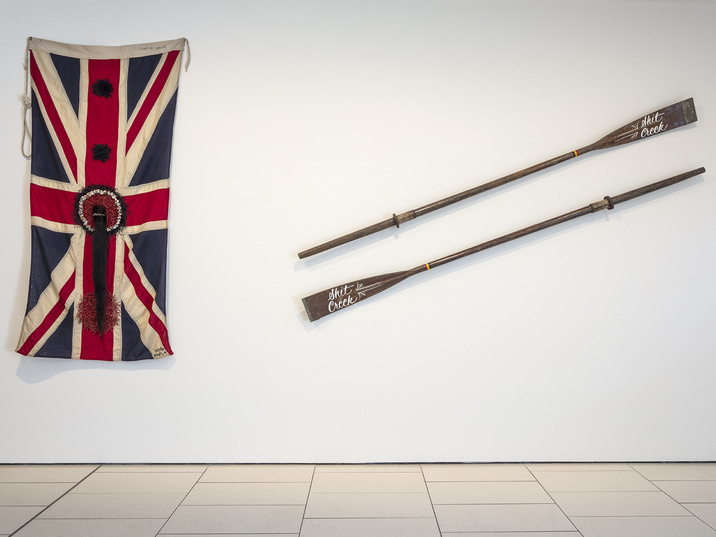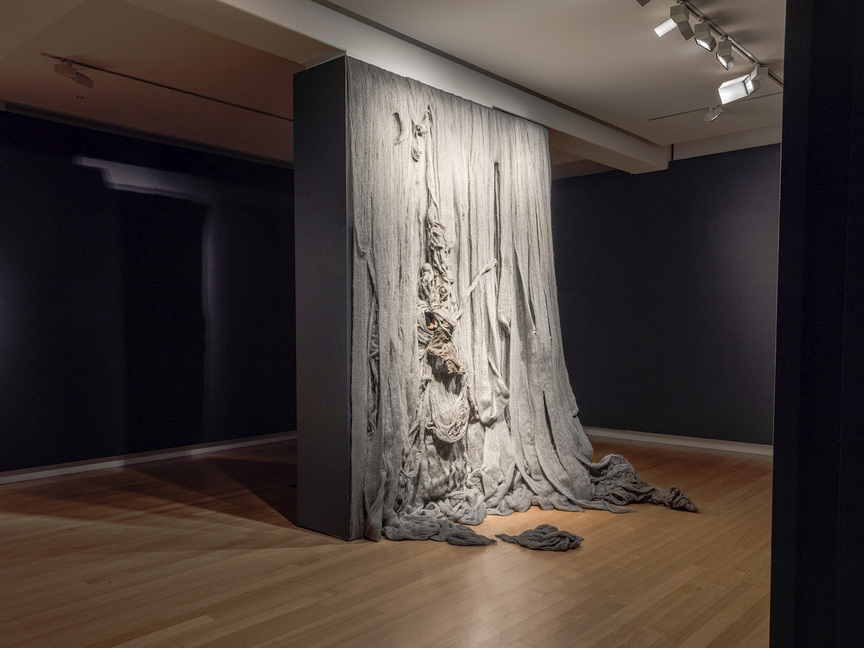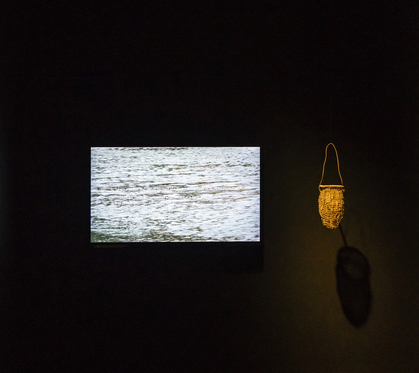-
From Current Issue
-
- Editor’s Letter Fire in the Heart
- Reviews I Gusti Ayu Kadek Murniasih
- Reviews 11th Seoul Mediacity Biennale: “One Escape at a Time”
- Dispatch Networked China
- One on One Monira Al Qadiri on Yukio Mishima
- Essays The rise of independent art spaces in pandemic-era Shanghai
- Features Tuan Andrew Nguyen
- Table of Contents
- Web Exclusives
- Archive
- Subscribe

R
E
V N
E
X
T
Installation view of “Rite of Passage,” at QUT Art Museum, Brisbane, 2020. Photo by Carl Warner. Courtesy QUT Art Museum.
The year 2020 marks a 250-year legacy of violence, silence, and dispossession in Australia. The “discovery” of the great southern land by British explorer James Cook in 1770 not only laid the foundations for colonial “settlement” (invasion) 18 years later but established a powerful and ingrained culture of denial based on the fallacy of the continent as terra nullius—the land of no one—which ignored more than 65,000 years of Indigenous civilization.
The exhibition “Rite of Passage”—curated by Shannon Brett, an artist of Wakka Wakka, Butchulla, and Gurang Gurang descent—reframed the year 2020 by celebrating the ongoing vitality, integrity, and innovation of contemporary Aboriginal Australian art through the work of 11 emerging and established artists. Upon entering QUT Art Museum’s low-ceilinged space, visitors faced Wiradjuri artist Karla Dickens’ Jack and Jill (A.K.A. Hung, strung and quartered) (2016), consisting of a portrait-oriented Union Jack flag; affixed to its center is a ring of shells, resembling teeth, that seems to either spew or consume a length of brown hair. Installed to the right of the flag, the broad heads of two paddles are emblazoned with “Shit Creek” and thin, horizontal bars of black, yellow, and red, referencing the colors of the Aboriginal flag. Recalling the colloquial phrase of being “up shit creek without a paddle,” Dickens’ work could be an allusion to the precarity many First Nations peoples experience in Australia, and perhaps offers the proverbial protagonist an oar to assist their safe passage.
Split into two wings, the museum offered two courses to explore the rest of the exhibition. In a gallery to the left, Wathaurung and Scottish artist Carol McGregor strung up across one wall a blended thread of possum fur and merino wool, bringing together the material traditions of her matrilineal family history. On the opposing wall was an early highlight: McGregor’s Wreath for Oodgeroo (2020), the latest in her ongoing series of possum-skin cloaks, following a traditional Wathaurung practice McGregor has revived in a contemporary context. Such cloaks were created for newborns, with additional patterned skins added as the wearers approached adulthood. Utilizing multiple skins sewn together to create an adult-sized wrap, McGregor emblazoned the skin side of the cloak with a wreath of native bush flowers in remembrance of the late Quandamooka activist-poet Oodgeroo Noonuccal (Kath Walker); the blooms were sourced from Noonuccal’s home on Minjerribah (North Stradbroke Island).
In another gallery, Palawa woman Mandy Quadrio’s sculptural incursion of thick strands of steel wool Striking at the foundations (2020) spilled down from the ceiling of the spotlit space, the typically coarse material appearing velvet-soft in places. Within these cascading waves, which Brett describes in the catalogue as reflecting the instability of historical transition, a small nest-like nook seems to offer a place of refuge. Meanwhile, in Megan Cope’s 2014 video The Blaktism, the Melbourne-based Quandamooka artist undergoes a satirical baptism to authenticate her “blackness,” presided by a group of stereotypical Australians, including hipsters, bikini-clad women, and a benign priest who anoints the artist’s body with brown body paint. Cope here skewers the process of proving to settler bureaucracy her “credentials” as an Aboriginal woman, a hurdle Cope faced when applying for a residency in Paris. At the video’s end, Cope reverses the ritual by wiping the body paint off while looking defiantly into the camera.
In the right-hand galleries, one found Julie Gough’s standout video Crime scene (Survivor) (2019–20), a harrowing recollection of the forced servitude and nonfatal shooting of the artist’s 19th century ancestor Dalrymple Briggs, elucidated through details of the landscape surrounding a colonial Tasmanian homestead. Another highlight was Trawlwoolway Elder Lola Greeno’s finely-detailed shell necklaces utilizing different pearlescent varieties collected from Tasmania’s and the Furneaux Islands’ coastlines.
“Rite of Passage” championed the voices of an array of Aboriginal artists with practices that both preserve ancestral cultural knowledge and develop new material expressions of marginalized narratives. By celebrating both the quality and innovation of these practitioners, the exhibition tackled the ongoing under-representation of artists of color in Australia—a point with particular resonance at the present moment and in the context of 250 years of colonial violence on this continent.
Tim Riley Walsh is ArtAsiaPacific’s Australia desk editor.
“Rite of Passage” is on view at the QUT Art Museum at the Queensland University of Technology, Brisbane, until August 16, 2020. A virtual tour of the exhibition is also available. Please check the exhibition web page for up-to-date information in light of Covid-19.
To read more of ArtAsiaPacific’s articles, visit our Digital Library.



















